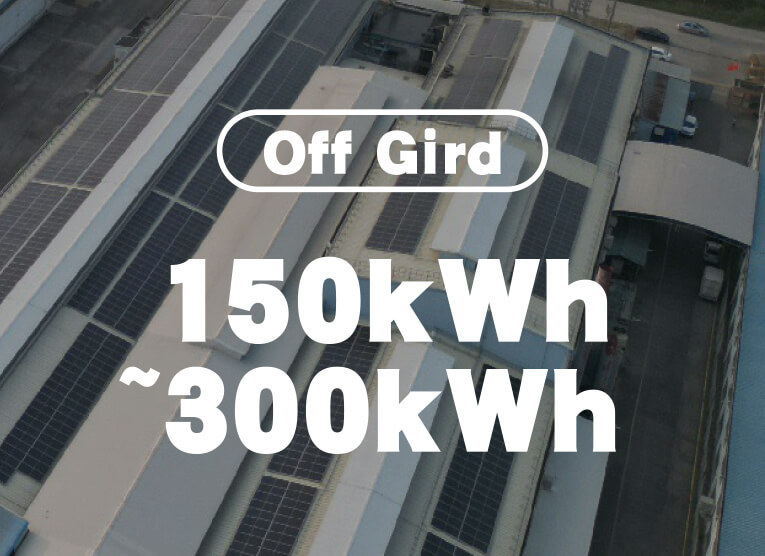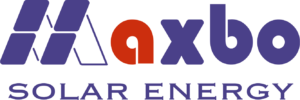How many batteries are required for a 50kW solar system?
Different choices can lead to a very big difference in the choice of batteries for a 50kW solar system. Generally speaking, depending on the situation, the required battery capacity from 50kWh to 300kWh are possible, we analyze each one below. There are two main factors that affect the battery capacity of a 50KW solar system:
1. The different working modes of the solar system:
grid-connected mode, hybrid mode, off-grid mode
2. The type of battery selected:
lithium batteries, gel batteries
The different working modes of the solar system



Grid-tied solar system (0kWh)
Grid-connected solar systems take the DC power converted by the solar panels and produce it into sinusoidal AC power through an inverter, which is delivered directly to the utility grid. Grid-connected solar systems do not require storage batteries to store electricity.
Hybrid Solar System (50kWh)
The hybrid solar system has two modes of operation: i.e., grid-connected mode of operation and off-grid mode of operation. 1
In the grid-connected mode, the solar system is connected to the public grid, and the DC power converted by the solar panels is produced into sinusoidal AC power by the inverter and delivered to the public grid;
In off-grid mode (e.g. public grid outage), the solar system does not sell electricity to the public grid, the system takes the DC power converted by the solar panels, part of which is produced into sinusoidal AC power by the inverter for use by the loads, and the excess is stored in the battery. During times of low solar energy or at night, the solar system can use the electricity from the storage batteries to produce AC power for use by the load.
Since the intensity of solar irradiation varies at any time during the day, the amount of power generated by the solar system also varies at any time. For hybrid solar systems, the role of the storage battery is to smooth and stabilize the input on the DC side of the inverter, to provide power to the loads at night or on cloudy or rainy days, and to act as an emergency back-up power source to supply important loads when the public grid is out of power. The storage battery can fully utilize the solar energy and reduce the electricity bill of the public grid.
So for a 50KW hybrid solar system isn’t the larger the battery capacity the better?
The larger the battery capacity, the more power the system can store, the longer the backup time, the more the solar system can fully utilize the solar energy, reduce the phenomenon of “abandoned light” waste, and at the same time increase the reliability of the solar system power supply. But too much configuration of the battery capacity, will increase the investment cost of solar energy system, prolong the solar energy system investment payback time length.
Generally speaking, if the public power grid is relatively stable and there are few temporary power outages, for hybrid solar systems, the capacity of the storage battery and the total PV power of the solar system is configured according to 1:1. Then, a 50KW hybrid solar system with a 50KWH storage battery is sufficient.
Off-grid solar systems (150kWh~300kWh)
Off-grid solar system cannot sell electricity to the grid.
The system adopts the VF control strategy to build an independent grid system with stable voltage and frequency. As the size of the load changes, the AC output power of the inverter of the off-grid solar system will be adjusted at any time to keep the load power and the AC output power of the inverter the same size.
Generally speaking, the larger the battery capacity, the more power the system stores, the longer the backup time, the solar system can fully utilize the solar energy, for the off-grid solar system can not sell electricity, greatly reducing the phenomenon of “abandoned light” waste, while increasing the reliability of the solar energy system in the continuous cloudy and rainy days and other extreme weather power supply. But too much configuration of battery capacity, will increase the investment cost of solar energy system. It is up to the customer to weigh the investment cost and the reliability of the solar system in terms of the capacity of the battery.
Can be connected to the public grid (150kWh)
When the solar system runs out of power, the system can automatically switch to the public grid to continue to supply power to the loads and also charge the batteries.
Generally speaking, if the off-grid solar system can be connected to the public grid, the solar system can be supplemented by the public grid when there is no electricity. Then, the battery capacity of the system and the total power of the PV is configured according to 3:1, a 50KW off-grid solar configuration of 150KWH storage battery is enough.
Completely off-grid (200kWh~300kWh)
Off-grid solar systems are mostly installed in areas with no electricity or unstable power grids, where customers rely heavily on the electricity consumption of the solar system and demand high reliability from the solar system.
Off-grid solar system takes the DC power converted by the solar panels and part of it is produced into sinusoidal AC power by the inverter for use by the loads, and the excess is stored in the batteries, and when there is not enough solar power or at night, the solar system can use the power from the storage batteries to produce AC power for use by the loads.
If the off-grid solar system works completely off the public grid, then the battery capacity of the system and the total power of the PV are configured according to 4:1 or 5:1 or even 6:1, and a 50KW off-grid solar needs to be configured with 200-300KWH of storage batteries.
Different types of batteries selected
The most common energy storage batteries on the market today are lithium iron phosphate batteries and gel batteries, and the main performance parameters of the two different types of energy storage batteries are compared as follows:
| Comparison Items | Lithium Battery | Gel Battery |
|---|---|---|
| Power density (mAh/g) | 120-150 | 30-45 |
| Discharge platform (V) | 3.2-3.3 | 2.0 |
| Cycling performance (80% DOD) | 4000-5000 | 600-1000 |
| Recommended depth of charge/discharge (DOD, %) | 80 | 60 |
Through the above comparison, we can find that the depth of charge and discharge (DOD) of LiFePO4 and gel batteries are not the same, for 50KW solar system, if you need to configure the available battery capacity of 50kWH, then when selecting the rated capacity of the battery, use the value of the DOD to make corrections.
For example, for a 50KW solar system, if you need to configure a lithium iron phosphate battery with a usable battery capacity of 50kWH, then select the rated capacity of the lithium iron phosphate battery
= 50kWH/80% = 62.5KWh
For example, 50KW solar system, if you need to configure the gel battery, need to be available battery capacity is also 50kWH, then choose the gel battery rated capacity
= 50kWH/60% = 83.3KWh
In conclusion, from the above two aspects, 50KW solar energy system requires different battery capacity, the main factors affecting the solar energy system type is not the same and the configuration of the storage battery type is not the same. In the design of solar energy system, usually according to the customer’s electricity demand, assess the system’s safety, economy, reliability and many other factors, comprehensive consideration, configure a reasonable capacity of energy storage battery.
Contact Maxbo for more information:
E-mail: [email protected]










